Coupled U–Pb Geochronology of Monazite and Zircon for the Bozhushan Batholith, Southeast Yunnan Province, China: Implications for Regional Metallogeny
Abstract
:1. Introduction
2. Geological Setting
2.1. Regional Geology
2.2. Petrography of Bozhushan Batholith
3. Analytical Methods
3.1. Seperation and Cathodoluminescence Images of Zircon and Monazite
3.2. In-Situ Zircon LA-ICP-MS U–Pb Dating
3.3. In-Situ Monazite LA-ICP-MS U–Pb Dating
4. Results
4.1. Morphology and CL Signatures of Zircon and Monazite
4.2. U–Pb Geochronology of Zircon
4.3. U–Pb Geochronology of Monazite
4.4. Rare Earth Element Patterns of Zircon and Monazite
5. Discussion
Author Contributions
Funding
Acknowledgments
Conflicts of Interest
References
- Zhang, S.T.; Chen, C.G. Geological characteristics and evolution rule of Bozhushan complex granite in southeastern Yunnan. Yunnan Geol. 1997, 16, 222–232, (In Chinese with English abstract). [Google Scholar]
- Mao, J.W.; Xie, G.Q.; Guo, C.L.; Chen, Y.C. Large-scale tungsten–tin mineralization in the Nanling region, South China: Metallogenic ages and corresponding geodynamic processes. Acta Petrol. Sin. 2007, 23, 2329–2338, (In Chinese with English abstract). [Google Scholar]
- Xie, H.J.; Zhang, Q.; Zhu, C.H. Petrology and REE-trace element geochemistry of Bozhushan Granite Pluton in Southeastern Yunnan Province, China. Acta Mineral. Sin. 2009, 29, 481–490, (In Chinese with English abstract). [Google Scholar]
- Cheng, Y.B.; Mao, J.W.; Chen, X.L.; Li, W. LA-ICP-MS zircon U–Pb dating of the Bozhushan granite in southeastern Yunnan province and its significance. J. Jilin Univ. (Earth Sci. Ed.) 2010, 40, 869–878, (In Chinese with English abstract). [Google Scholar]
- Cheng, Y.B.; Mao, J.W.; Liu, P. Geodynamic setting of Late Cretaceous Sn–W mineralization in southeastern Yunnan and northeastern Vietnam. Solid Earth Sci. 2016, 1, 79–88. [Google Scholar] [CrossRef]
- Zhang, Y.; Zhang, S.; Tan, S.; Cui, Y.; Zhao, Z.; Jiang, Y.; Jiang, S.; Tao, S. The genetic relationship between the large Guanfang W deposit and granitic intrusions, in Yunnan Province, southwest China: Evidence from U Pb and Re Os geochronology and Pb and Sr isotopic characteristics. Ore Geol. Rev. 2016, 79, 332–345. [Google Scholar] [CrossRef]
- Cheng, Y.B.; Mao, J.W. Age and geochemistry of granites in Gejiu area, Yunnan province, SW China: Constraints on their petrogenesis and corresponding tectonic setting. Lithos 2010, 120, 258–276. [Google Scholar] [CrossRef]
- Zhao, Z.Y.; Hou, L.; Ding, J.; Zhang, Q.M.; Wu, S.Y. A genetic link between Late Cretaceous granitic magmatism and Sn mineralization in the southwestern South China Block: A case study of the Dulong Sn-dominant polymetallic deposit. Ore Geol. Rev. 2018, 93, 268–289. [Google Scholar] [CrossRef]
- Zhang, H.; Gao, Z.M.; Ma, D.Y.; Tao, Y. Pb isotopic compositions and its significance in ore genesis in Gejiu tin-polymetallic deposits. Acta Mineral. Sin. 2004, 24, 149–152, (In Chinese with English abstract). [Google Scholar]
- Zhang, Y.H.; Zhang, S.T. Geochemical characteristics of granite in the Guanfang tungsten deposit of Wenshan, Yunnan Province and its geological implications. Geol. Explor. 2011, 47, 1002–1008, (In Chinese with English abstract). [Google Scholar]
- Cherniak, D.J.; Watson, E.B.; Grove, M.; Harrison, T.M. Pb diffusion in monazite: A combined RBS/SIMS study. Geochim. Cosmochim. Acta 2004, 68, 829–840. [Google Scholar] [CrossRef]
- Foster, G.; Kinney, P.; Vance, D.; Prince, C.; Harris, N. The significance of monazite U-Th-Pb age data in metamorphic assemblages; a combined study of monazite and garnet chronometry. Earth Planet. Sci. Lett. 2000, 181, 327–340. [Google Scholar] [CrossRef]
- Catlos, E.J.; Gilley, L.D.; Harrison, T.M. Interpretation of monazite ages obtained via in situ analysis. Chem. Geol. 2002, 188, 193–215. [Google Scholar] [CrossRef]
- Smith, H.A.; Giletti, B.J. Lead diffusion in monazite. Geochim. Cosmochim. Acta 1997, 61, 1047–1055. [Google Scholar] [CrossRef]
- Meldrum, A.; Boatner, L.A.; Weber, W.J.; Ewing, R.C. Radiation damage in zircon and monazite-radiation dose-dependent structural characteristics. Geochim. Cosmochim. Acta 1998, 62, 2509–2520. [Google Scholar] [CrossRef]
- Suzuki, K.; Adachi, M.; Kajizuka, I. Electron microprobe observations of Pb diffusion in metamorphosed detrital monazites. Earth Planet. Sci. Lett. 1994, 128, 391–405. [Google Scholar] [CrossRef]
- Chappell, B.W.; White, A.J.R. Two contrasting granite types: 25 years later. Aust. J. Earth Sci. 2001, 48, 489–499. [Google Scholar] [CrossRef]
- Alagna, K.E.; Petreli, M.; Perugini, D.; Poli, D. Micro-analytical zircon and monazite U-Pb isotope dating by laser ablation-inductively coupled plasma-quadrupole mass spectrometry. Geostand. Geoanal. Res. 2008, 32, 103–120. [Google Scholar] [CrossRef]
- Li, J.D. Geochemistry, Zircon U-Pb Geochronology and Implication for Tectonic Setting of the Bozhushan Granite in Southeastern Yunnan Province, SW China. Master Thesis, China University of Geosciences, Beijing, China, 2018. (In Chinese with English abstract). [Google Scholar]
- Ouyang, Y.P. Diversity of Mineralization and Spectrum of Tungsten-Tin Polymetallic Deposits in Southeastern Yunnan Province, China. Master Thesis, China University of Geosciences, Wuhan, China, 2013. (In Chinese with English abstract). [Google Scholar]
- Li, K.W.; Zhang, Q.; Wang, D.P.; Cai, Y.; Liu, Y.P. LA-MC-ICP-MS U-Pb geochronology of cassiterite from the Bainiuchang polymetallic Deposit, Yunnan Province, China. Acta Mineral. Sin. 2013, 33, 203–209, (In Chinese with English abstract). [Google Scholar]
- Zhang, H.P.; Liu, J.S.; Li, X.B.; Zhang, X.L. Relationship of granites to tin, silver, copper, lead, zinc, polymetallic deposits in southeastern Yunnan, China. Contrib. Geol. Miner. Resour. Res. 2006, 21, 87–90, (In Chinese with English abstract). [Google Scholar]
- Zhang, Q.; Li, K.W.; Wang, D.P.; Hou, X.F. New geological and geochemical evidence of Bainiuchang polymetallic deposit in southeastern Yunnan. Acta Miner. Sin. 2009, 29, 355–356, (In Chinese with English abstract). [Google Scholar]
- Zhang, H.P. Bainiuchang Sliver Polymetallic Deposit in Mengzi, Yunnan Province: A Granite-related Supergiant Deposit. PhD Thesis, Centrl South University, Changsha, China, 2007. (In Chinese with English abstract). [Google Scholar]
- Chen, X.C.; Hu, R.Z.; Bi, X.W.; Zhong, H.; Lan, J.B.; Zhao, C.H.; Zhu, J.J. Zircon U–Pb ages and Hf–O isotopes, and whole-rock Sr–Nd isotopes of the Bozhushan granite, Yunnan province, SW China: Constraints on petrogenesis and tectonic setting. J. Asian Earth Sci. 2015, 99, 57–71. [Google Scholar] [CrossRef]
- Zong, K.Q.; Klemd, R.; Yuan, Y.; He, Z.Y.; Guo, J.L.; Shi, X.L.; Liu, Y.S.; Hu, Z.C.; Zhang, Z.M. The assembly of Rodinia: The correlation of early Neoproterozoic (ca.900Ma) high-grade metamorphism and continental arc formation in the southern Beishan Orogen, southern Central Asian Orogenic Belt (CAOB). Precambrian Res. 2017, 290, 32–48. [Google Scholar] [CrossRef]
- Wiedenbeck, M.; Hanchar, J.M.; Peck, W.H.; Sylvester, P.; Valley, J.; Whitehouse, M.; Franchi, I. Further characterisation of the 91500 zircon crystal. Geostand. Geoanal. Res. 2004, 28, 9–39. [Google Scholar] [CrossRef]
- Wiedenbeck, M.; Alle, P.; Corfu, F.; Griffin, W.L.; Meier, M.; Oberli, F.V.; Von Quadt, A.; Roddick, J.C.; Spiegel, W. Three natural zircon standards for U-Th-Pb, Lu-Hf, trace element and REE analyses. Geostand. Newslett. 1995, 19, 1–23. [Google Scholar] [CrossRef]
- Liu, Y.S.; Hu, Z.C.; Gao, S.; Günther, D.; Xu, J.; Gao, C.G.; Chen, H.H. In situ analysis of major and trace elements of anhydrous minerals by LA-ICP-MS without applying an internal standard. Chem. Geol. 2008, 257, 34–43. [Google Scholar] [CrossRef]
- Liu, Y.S.; Gao, S.; Hu, Z.C.; Gao, C.G.; Zong, K.Q.; Wang, D.B. Continental and oceanic crust recycling-induced melt-peridotite interactions in the Trans-North China Orogen: U-Pb dating, Hf isotopes and trace elements in zircons of mantle xenoliths. J. Petrol. 2010, 51, 537–571. [Google Scholar] [CrossRef]
- Ludwig, K.R. ISOPLOT 3.00: A Geochronological Toolkit for Microsoft Excel; Special Publication/Berkeley Geochronology Center: Berkeley, CA, USA, 2003; Volume 4, pp. 1–71. [Google Scholar]
- Anderson, T. Correction of common lead in U-Pb analyses that do not report 204Pb. Chem. Geol. 2002, 192, 59–79. [Google Scholar] [CrossRef]
- Hu, Z.C.; Zhang, W.; Liu, Y.S.; Hu, Z.C.; Zhang, W.; Liu, Y.S.; Gao, S.; Li, M.; Zong, K.Q.; Chen, H.H.; et al. “Wave” signal smoothing and mercury removing device for laser ablation quadrupole and multiple collector ICP-MS analysis: Application to lead isotope analysis. Anal. Chem. 2015, 87, 1152–1157. [Google Scholar] [CrossRef]
- Zong, K.Q.; Chen, J.Y.; Hu, Z.C.; Liu, Y.S.; Li, M.; Fan, H.H.; Meng, Y.N. In-situ U-Pb dating of uraninite by fs-LA-ICP-MS. Sci. China Earth Sci. 2015, 58, 1731–1740. [Google Scholar] [CrossRef]
- Aleinikoff, J.N.; Schenck, W.S.; Plank, M.O.; Srogi, L.; Fanning, C.M.; Kamo, S.L. Deciphering igneous and metamorphic events in high grade rocks of the Wilmington Complex, Delaware: Morphology, cathodoluminescence and backscattered electron zoning, and SHRIMP U-Pb geochronology of zircon and monazite. Geol. Soc. Am. Bull. 2006, 118, 39–64. [Google Scholar] [CrossRef]
- Tomascak, P.B.; Krogstad, E.J.; Walker, R.J. U-Pb monazite geochronology of granitic rocks from Maine: Implications for Late Paleozoic tectonics in the northern Appalachians. J. Geol. 1996, 104, 185–195. [Google Scholar] [CrossRef]
- Hoskin, P.W.O.; Black, L.P. Metamorphic zircon formation by solid: Tate recrystallization of protolith igneous zircon. J. Metamorph. Geol. 2001, 18, 423–439. [Google Scholar] [CrossRef]
- Taylor, S.R.; McLennan, S.M. The Continental Crust: Its Composition and Evolution; Blackwell Scientific Publications: Oxford, UK, 1985; pp. 1–312. [Google Scholar]
- Blevin, P.L. Redox and compositional parameters for interpreting the granite metallogeny of Eastern Australia: Implications for gold-rich ore system. Resour. Geol. 2004, 54, 241–252. [Google Scholar] [CrossRef]
- Cheng, Y.B.; Mao, J.W.; Chang, Z.; Pirajno, F. The origin of the world class tin-polymetallic deposits in the Gejiu district, SW China: Constraints from metal zoning characteristics and 40Ar–39Ar geochronology. Ore Geol. Rev. 2013, 53, 50–62. [Google Scholar] [CrossRef]
- Cheng, Y.B.; Mao, J.W.; Spandler, C. Petrogenesis and geodynamic implications of the Gejiu igneous complex in the western Cathaysia block, South China. Lithos 2013, 175–176, 213–229. [Google Scholar] [CrossRef]
- Liu, Y.P.; Li, Z.X.; Li, H.M. U-Pb geochronology of cassiterite and zircon from the Dulong Sn-Zn deposit: Evidence for Cretaceous large-scale granitic magmatism and mineralization events in southeastern Yunnan province. China. Acta Petrol. Sin. 2007, 23, 967–976, (In Chinese with English abstract). [Google Scholar]
- Feng, J.R.; Mao, J.W.; Pei, R.F. Ages and geochemistry of Laojunshan granites in southeastern Yunnan, China: Implications for Sn-W polymetallic ore deposits. Mineral. Petrol. 2013, 107, 573–589. [Google Scholar] [CrossRef]
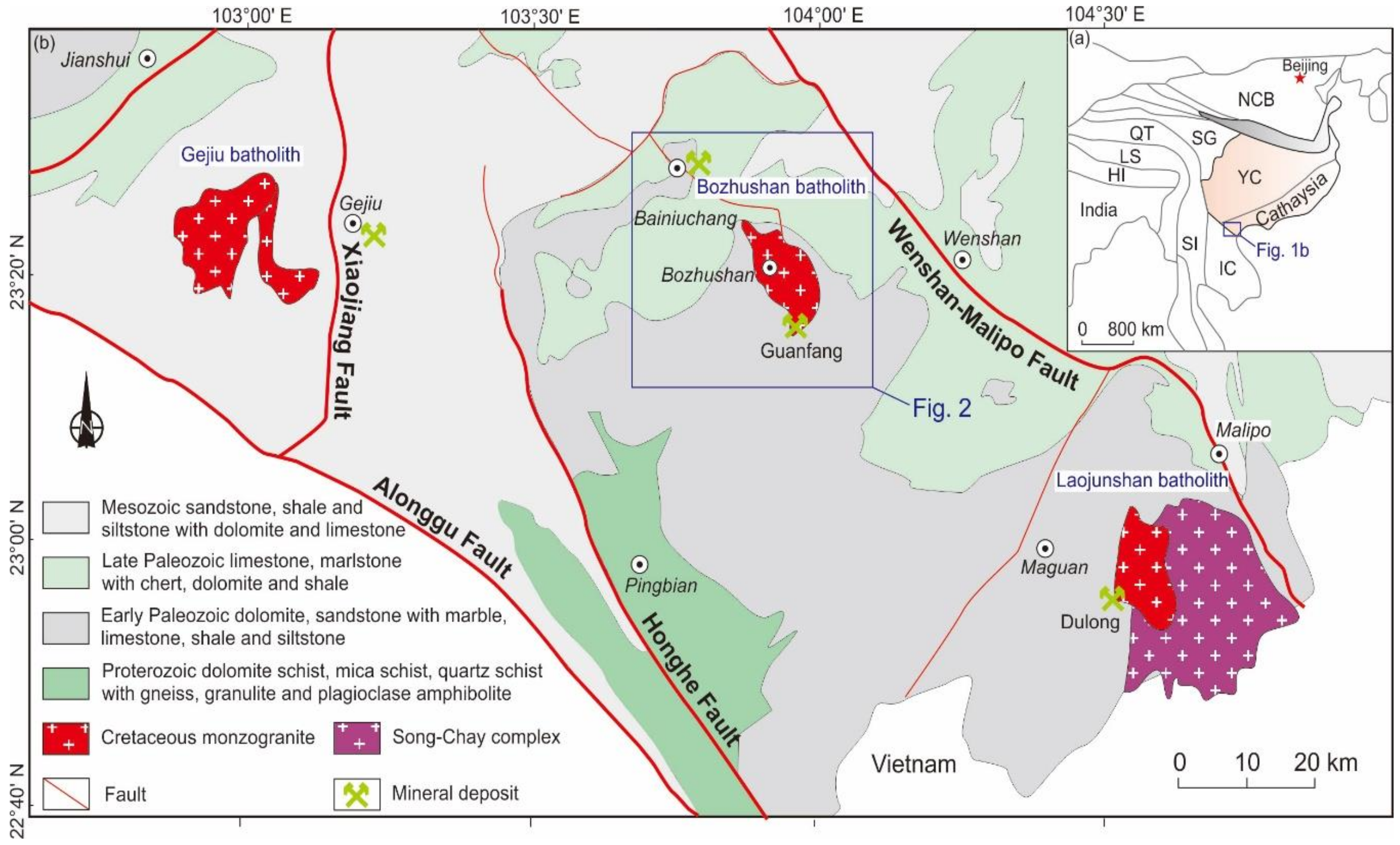
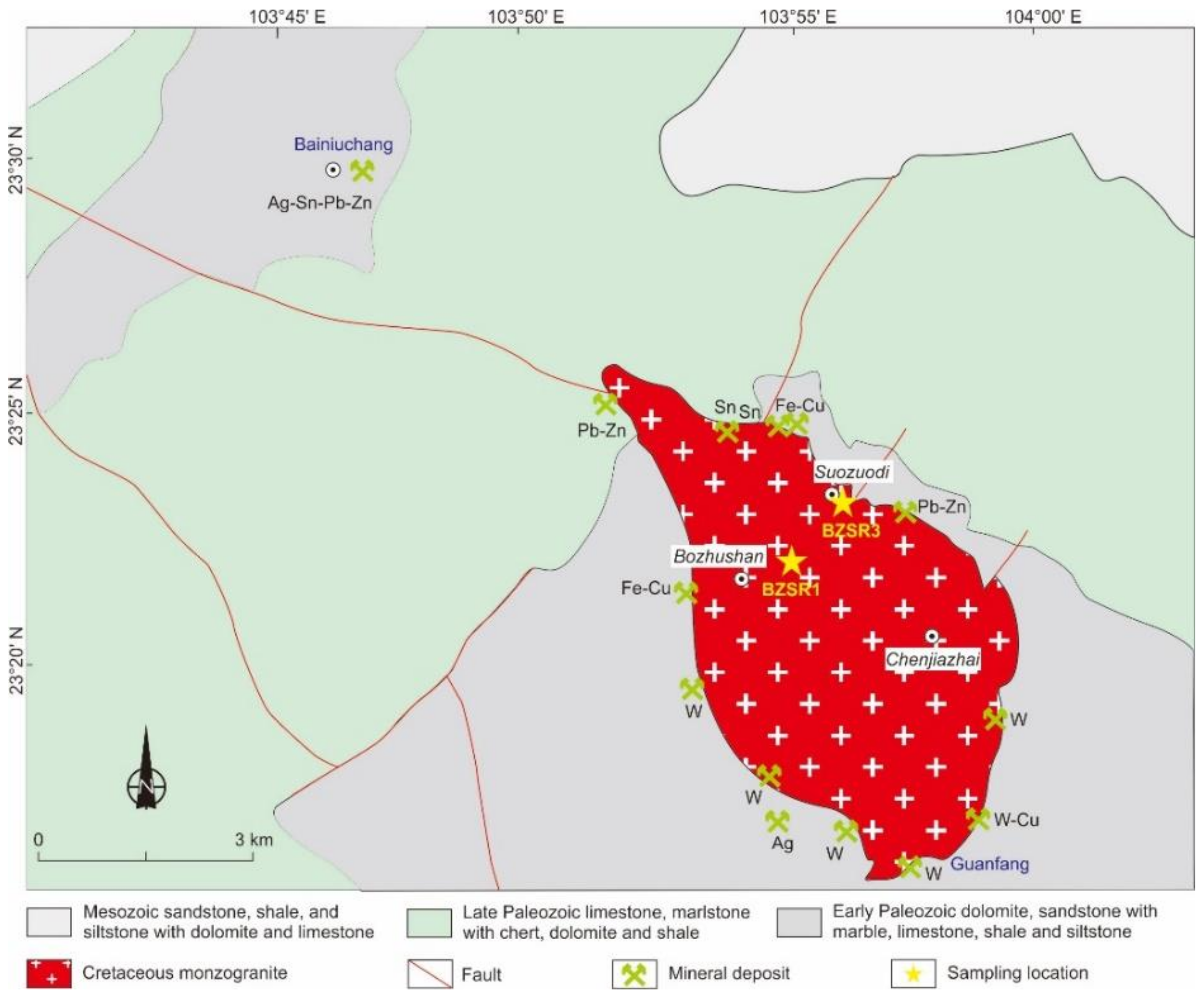
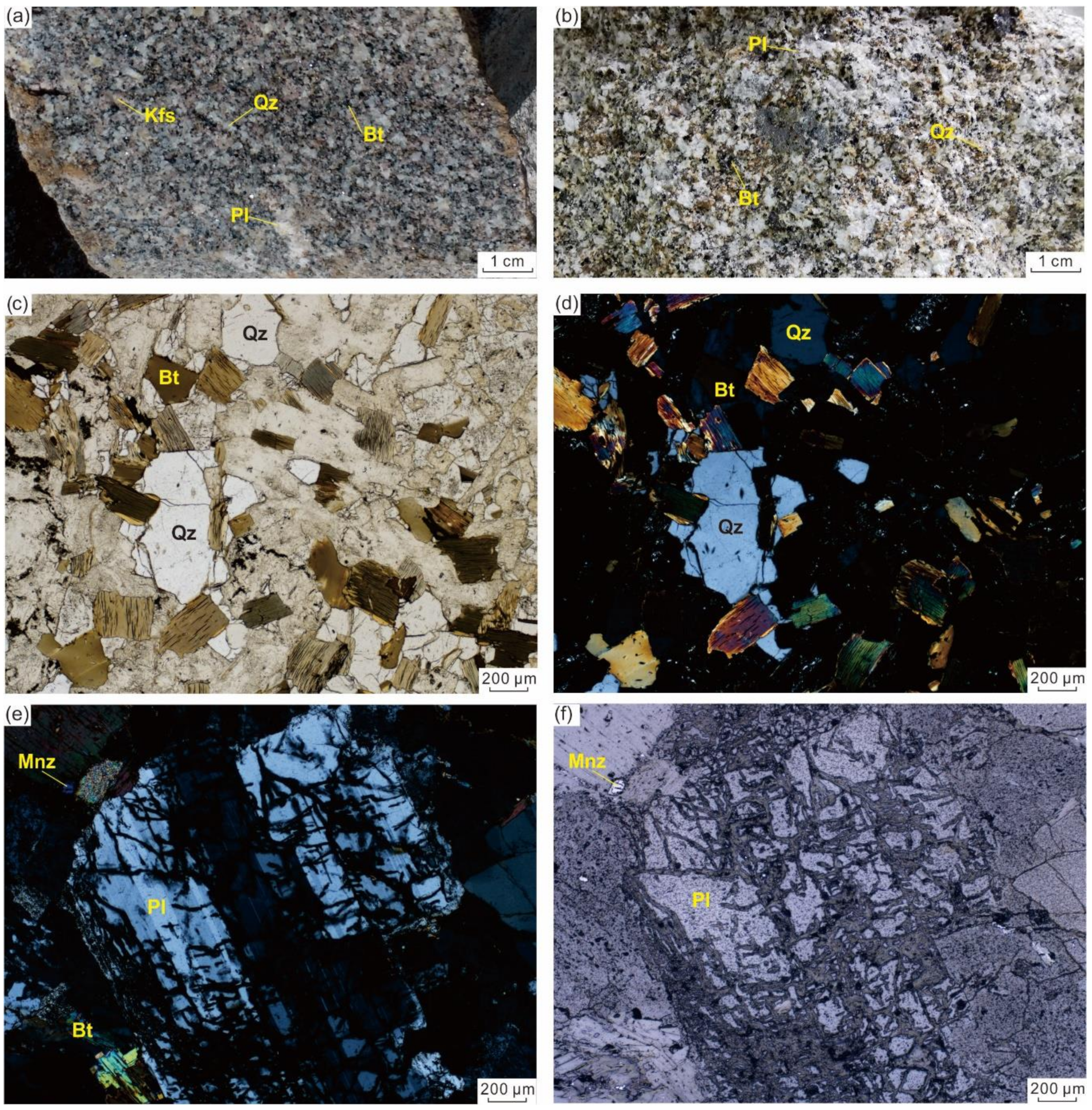
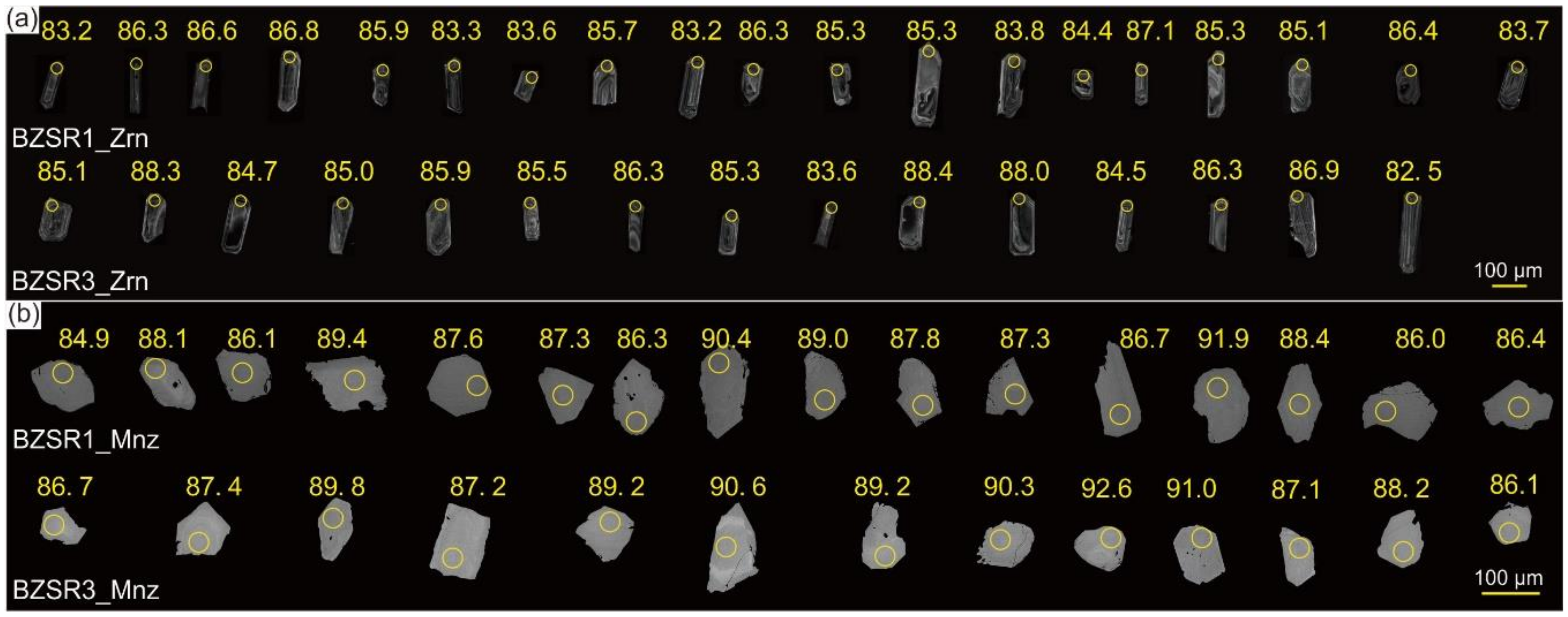
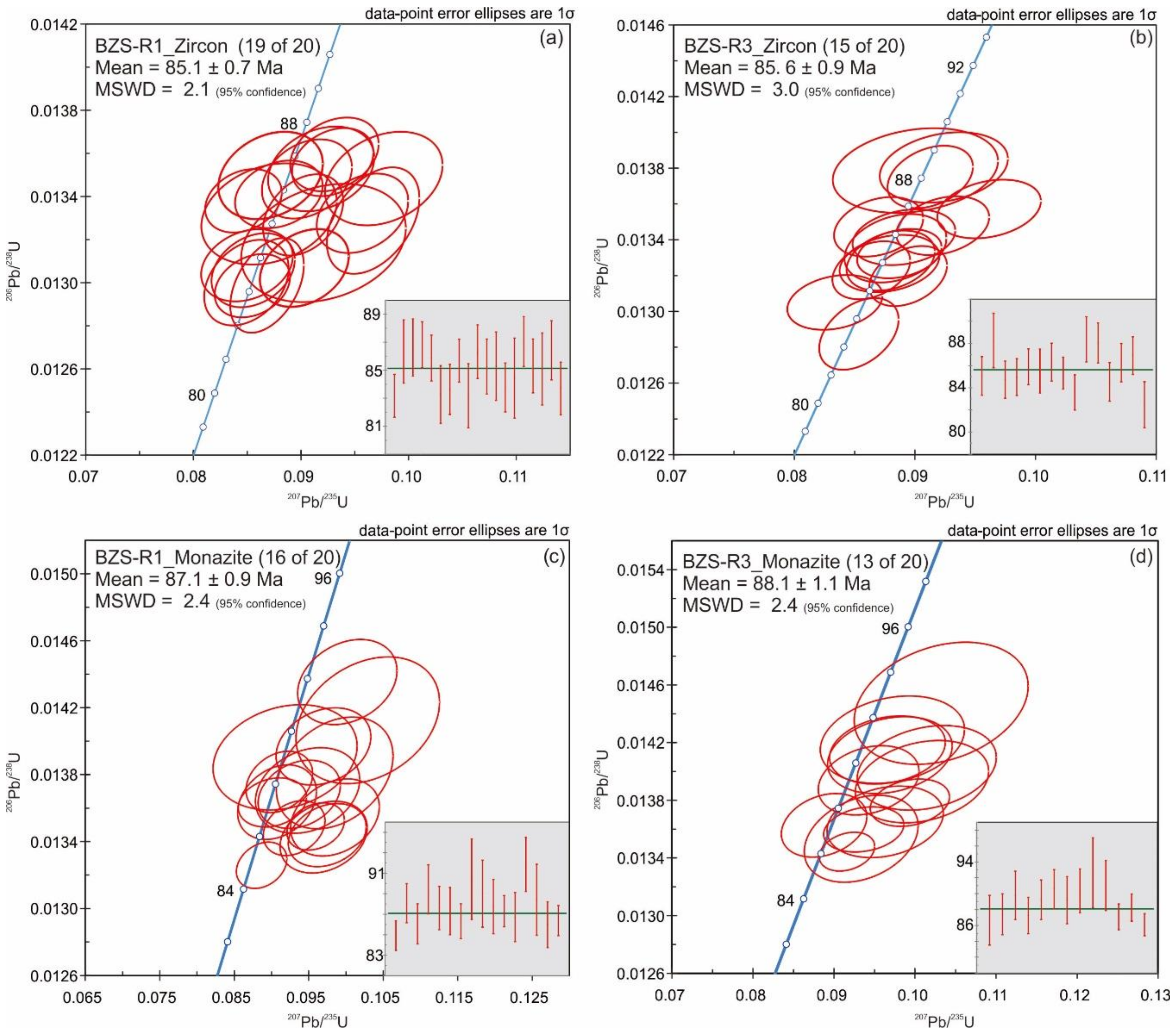
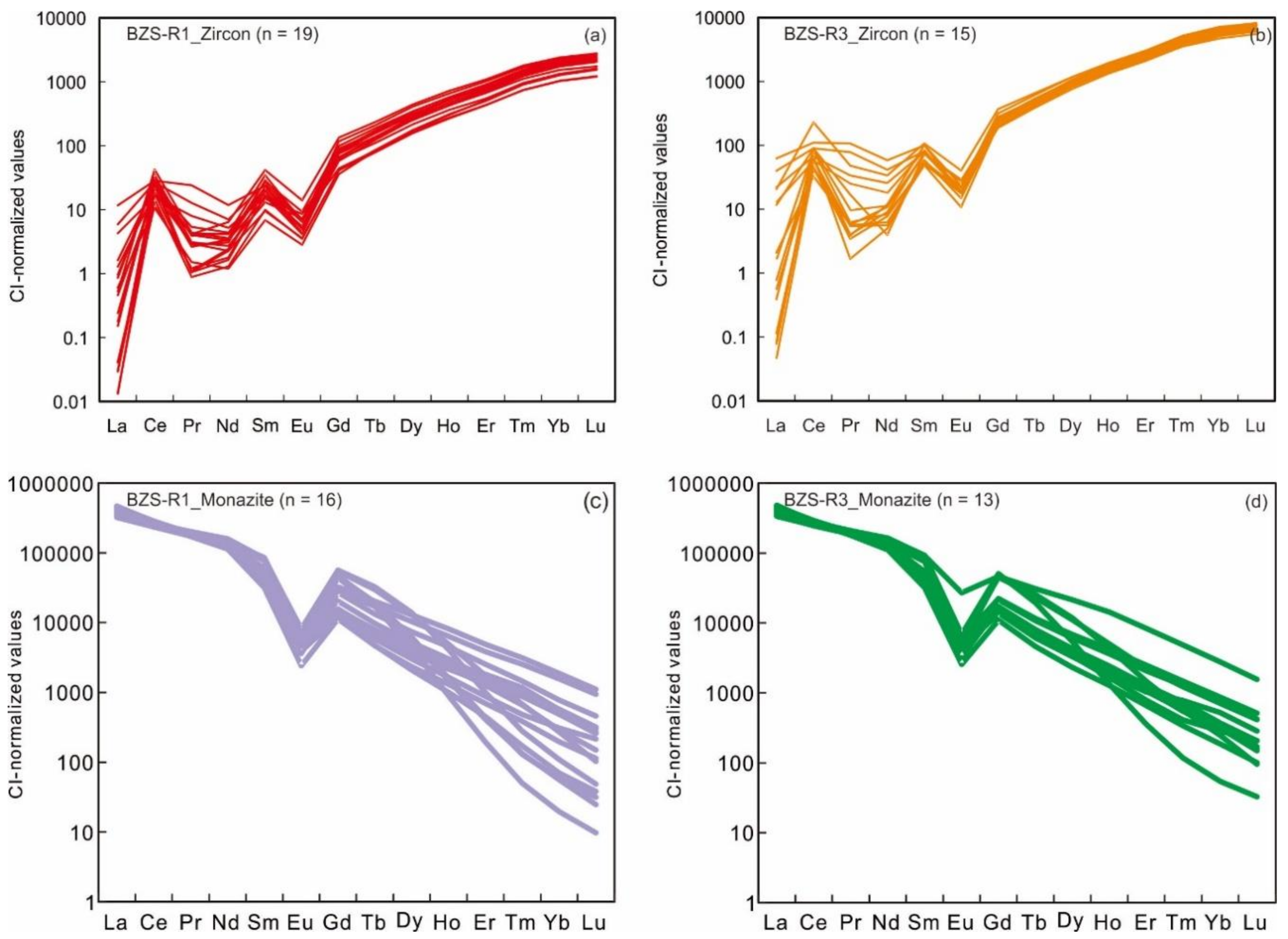
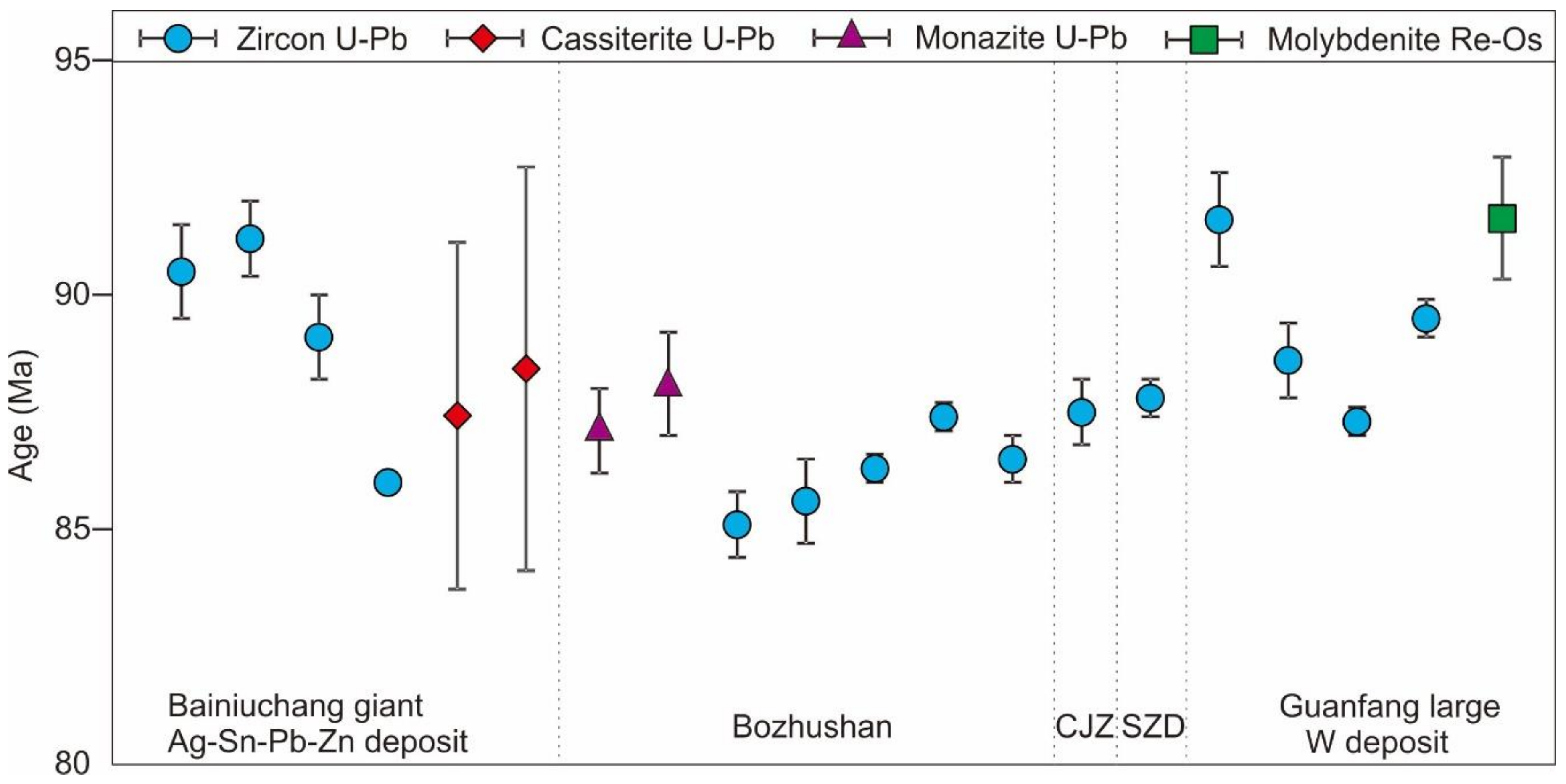
| Spot No. | Th | U | Th/U | Isotopic Ratios | Age (Ma) | |||||||
|---|---|---|---|---|---|---|---|---|---|---|---|---|
| (ppm) | (ppm) | 207Pb/235U | 1σ | 206Pb/238U | 1σ | RHO | 207Pb/235U | 1σ | 206Pb/238U | 1σ | ||
| BZSR1-01 | 286 | 1597 | 0.2 | 0.0855 | 0.0029 | 0.0130 | 0.0001 | 0.2764 | 83.3 | 2.7 | 83.2 | 0.8 |
| BZSR1-02 | 1204 | 1057 | 1.1 | 0.0977 | 0.0045 | 0.0135 | 0.0002 | 0.2883 | 94.6 | 4.1 | 86.3 | 1.1 |
| BZSR1-03 | 329 | 906 | 0.4 | 0.0919 | 0.0040 | 0.0135 | 0.0002 | 0.2707 | 89.2 | 3.7 | 86.6 | 1.0 |
| BZSR1-04 | 506 | 1682 | 0.3 | 0.0929 | 0.0031 | 0.0136 | 0.0001 | 0.2864 | 90.2 | 2.9 | 86.8 | 0.8 |
| BZSR1-06 | 596 | 1641 | 0.4 | 0.0879 | 0.0033 | 0.0134 | 0.0001 | 0.2526 | 85.6 | 3.1 | 85.9 | 0.8 |
| BZSR1-07 | 469 | 1692 | 0.3 | 0.0849 | 0.0032 | 0.0130 | 0.0002 | 0.3305 | 82.8 | 3.0 | 83.3 | 1.0 |
| BZSR1-08 | 303 | 1144 | 0.3 | 0.0856 | 0.0032 | 0.0131 | 0.0001 | 0.2908 | 83.4 | 3.0 | 83.6 | 0.9 |
| BZSR1-09 | 581 | 1484 | 0.4 | 0.0847 | 0.0029 | 0.0134 | 0.0001 | 0.2619 | 82.5 | 2.7 | 85.7 | 0.8 |
| BZSR1-10 | 1520 | 2118 | 0.7 | 0.0868 | 0.0028 | 0.0130 | 0.0002 | 0.4301 | 84.6 | 2.6 | 83.2 | 1.1 |
| BZSR1-11 | 603 | 1256 | 0.5 | 0.0905 | 0.0034 | 0.0135 | 0.0002 | 0.2955 | 88.0 | 3.2 | 86.3 | 1.0 |
| BZSR1-12 | 1015 | 1644 | 0.6 | 0.0902 | 0.0030 | 0.0133 | 0.0002 | 0.3432 | 87.7 | 2.8 | 85.3 | 1.0 |
| BZSR1-13 | 248 | 1005 | 0.2 | 0.0870 | 0.0051 | 0.0133 | 0.0002 | 0.2440 | 84.7 | 4.8 | 85.3 | 1.2 |
| BZSR1-14 | 525 | 1185 | 0.4 | 0.0850 | 0.0035 | 0.0131 | 0.0001 | 0.2554 | 82.8 | 3.3 | 83.8 | 0.9 |
| BZSR1-15 | 306 | 440 | 0.7 | 0.0921 | 0.0063 | 0.0132 | 0.0002 | 0.2504 | 89.5 | 5.8 | 84.4 | 1.4 |
| BZSR1-16 | 508 | 1507 | 0.3 | 0.0931 | 0.0034 | 0.0136 | 0.0001 | 0.2852 | 90.4 | 3.1 | 87.1 | 0.9 |
| BZSR1-17 | 682 | 1346 | 0.5 | 0.0957 | 0.0035 | 0.0133 | 0.0002 | 0.3112 | 92.8 | 3.2 | 85.3 | 1.0 |
| BZSR1-18 | 944 | 2050 | 0.5 | 0.0967 | 0.0035 | 0.0133 | 0.0002 | 0.4183 | 93.7 | 3.3 | 85.1 | 1.3 |
| BZSR1-19 | 397 | 857 | 0.5 | 0.0872 | 0.0040 | 0.0135 | 0.0002 | 0.2697 | 84.9 | 3.7 | 86.4 | 1.1 |
| BZSR1-20 | 677 | 1284 | 0.5 | 0.0903 | 0.0034 | 0.0131 | 0.0001 | 0.3021 | 87.8 | 3.1 | 83.7 | 0.9 |
| BZSR3-01 | 1234 | 3950 | 0.3 | 0.0880 | 0.0030 | 0.0133 | 0.0001 | 0.3038 | 85.6 | 2.8 | 85.1 | 0.9 |
| BZSR3-03 | 2160 | 2843 | 0.8 | 0.0900 | 0.0056 | 0.0138 | 0.0002 | 0.2252 | 87.5 | 5.2 | 88.3 | 1.2 |
| BZSR3-05 | 1469 | 4784 | 0.3 | 0.0864 | 0.0026 | 0.0132 | 0.0001 | 0.3281 | 84.1 | 2.5 | 84.7 | 0.8 |
| BZSR3-06 | 888 | 3270 | 0.3 | 0.0879 | 0.0034 | 0.0133 | 0.0001 | 0.2562 | 85.5 | 3.2 | 85.0 | 0.8 |
| BZSR3-07 | 1692 | 3668 | 0.5 | 0.0891 | 0.0035 | 0.0134 | 0.0001 | 0.2425 | 86.7 | 3.2 | 85.9 | 0.8 |
| BZSR3-08 | 1693 | 2968 | 0.6 | 0.0884 | 0.0035 | 0.0134 | 0.0002 | 0.2991 | 86.0 | 3.2 | 85.5 | 1.0 |
| BZSR3-10 | 1333 | 3830 | 0.3 | 0.0923 | 0.0031 | 0.0135 | 0.0001 | 0.2922 | 89.7 | 2.9 | 86.3 | 0.9 |
| BZSR3-11 | 1111 | 3525 | 0.3 | 0.0887 | 0.0029 | 0.0133 | 0.0001 | 0.2616 | 86.3 | 2.7 | 85.3 | 0.7 |
| BZSR3-13 | 1890 | 3086 | 0.6 | 0.0834 | 0.0032 | 0.0131 | 0.0001 | 0.2481 | 81.3 | 3.0 | 83.6 | 0.8 |
| BZSR3-14 | 3051 | 3065 | 1.0 | 0.0924 | 0.0043 | 0.0138 | 0.0002 | 0.2476 | 89.7 | 4.0 | 88.4 | 1.0 |
| BZSR3-15 | 1384 | 3628 | 0.4 | 0.0913 | 0.0029 | 0.0138 | 0.0001 | 0.3271 | 88.7 | 2.7 | 88.0 | 0.9 |
| BZSR3-16 | 1712 | 4042 | 0.4 | 0.0894 | 0.0026 | 0.0132 | 0.0001 | 0.3535 | 87.0 | 2.5 | 84.5 | 0.9 |
| BZSR3-17 | 1355 | 4096 | 0.3 | 0.0870 | 0.0030 | 0.0135 | 0.0001 | 0.2906 | 84.7 | 2.8 | 86.3 | 0.9 |
| BZSR3-18 | 1102 | 4553 | 0.2 | 0.0962 | 0.0035 | 0.0136 | 0.0001 | 0.2706 | 93.2 | 3.2 | 86.9 | 0.9 |
| BZSR3-19 | 1890 | 5270 | 0.4 | 0.0854 | 0.0027 | 0.0129 | 0.0002 | 0.4030 | 83.2 | 2.5 | 82.5 | 1.0 |
| Spot No. | Th (wt. %) | U (ppm) | Isotopic Ratios | Age (Ma) | |||||||
|---|---|---|---|---|---|---|---|---|---|---|---|
| 207Pb/235U | 1σ | 206Pb/238U | 1σ | RHO | 207Pb/235U | 1σ | 206Pb/238U | 1σ | |||
| BZSR1(MZ)-01 | 4.89 | 7565 | 0.0887 | 0.0028 | 0.0133 | 0.0001 | 0.2734 | 86.3 | 2.6 | 84.9 | 0.7 |
| BZSR1(MZ)-02 | 10.43 | 4086 | 0.0911 | 0.0037 | 0.0138 | 0.0001 | 0.2710 | 88.5 | 3.4 | 88.1 | 1.0 |
| BZSR1(MZ)-03 | 6.24 | 4503 | 0.0975 | 0.0043 | 0.0134 | 0.0002 | 0.2616 | 94.5 | 4.0 | 86.1 | 1.0 |
| BZSR1(MZ)-04 | 10.11 | 1879 | 0.0970 | 0.0052 | 0.0140 | 0.0002 | 0.2514 | 94.0 | 4.8 | 89.4 | 1.2 |
| BZSR1(MZ)-05 | 4.20 | 3046 | 0.0937 | 0.0045 | 0.0137 | 0.0002 | 0.2529 | 91.0 | 4.2 | 87.6 | 1.1 |
| BZSR1(MZ)-06 | 6.20 | 2452 | 0.0907 | 0.0043 | 0.0136 | 0.0002 | 0.2801 | 88.2 | 4.0 | 87.3 | 1.2 |
| BZSR1(MZ)-07 | 6.09 | 9033 | 0.0930 | 0.0034 | 0.0135 | 0.0001 | 0.2729 | 90.3 | 3.1 | 86.3 | 0.9 |
| BZSR1(MZ)-08 | 7.38 | 795 | 0.1029 | 0.0079 | 0.0141 | 0.0003 | 0.2863 | 99.5 | 7.2 | 90.4 | 2.0 |
| BZSR1(MZ)-09 | 4.67 | 953 | 0.0918 | 0.0079 | 0.0139 | 0.0003 | 0.2148 | 89.2 | 7.3 | 89.0 | 1.6 |
| BZSR1(MZ)-10 | 8.32 | 3022 | 0.0948 | 0.0057 | 0.0137 | 0.0002 | 0.2528 | 92.0 | 5.3 | 87.8 | 1.3 |
| BZSR1(MZ)-11 | 6.84 | 4041 | 0.0901 | 0.0037 | 0.0136 | 0.0001 | 0.2117 | 87.6 | 3.5 | 87.3 | 0.8 |
| BZSR1(MZ)-15 | 5.24 | 2147 | 0.0985 | 0.0049 | 0.0135 | 0.0002 | 0.2813 | 95.4 | 4.5 | 86.7 | 1.2 |
| BZSR1(MZ)-16 | 6.39 | 1915 | 0.1002 | 0.0055 | 0.0144 | 0.0002 | 0.2659 | 96.9 | 5.0 | 91.9 | 1.3 |
| BZSR1(MZ)-17 | 5.25 | 867 | 0.0985 | 0.0064 | 0.0138 | 0.0003 | 0.3040 | 95.4 | 5.9 | 88.4 | 1.7 |
| BZSR1(MZ)-18 | 5.46 | 3824 | 0.0970 | 0.0048 | 0.0134 | 0.0002 | 0.2650 | 94.0 | 4.4 | 86.0 | 1.1 |
| BZSR1(MZ)-19 | 7.67 | 6793 | 0.0959 | 0.0032 | 0.0135 | 0.0001 | 0.2596 | 93.0 | 2.9 | 86.4 | 0.7 |
| BZSR3(MZ)-01 | 7.03 | 1344 | 0.0934 | 0.0057 | 0.0135 | 0.0002 | 0.2961 | 90.6 | 5.3 | 86.7 | 1.6 |
| BZSR3(MZ)-02 | 1.54 | 2107 | 0.0963 | 0.0059 | 0.0137 | 0.0002 | 0.2437 | 93.4 | 5.4 | 87.4 | 1.3 |
| BZSR3(MZ)-03 | 7.48 | 1207 | 0.1015 | 0.0070 | 0.0140 | 0.0002 | 0.2471 | 98.1 | 6.5 | 89.8 | 1.5 |
| BZSR3(MZ)-04 | 4.90 | 2304 | 0.0888 | 0.0043 | 0.0136 | 0.0002 | 0.2724 | 86.4 | 4.0 | 87.2 | 1.1 |
| BZSR3(MZ)-06 | 4.49 | 1717 | 0.0943 | 0.0051 | 0.0139 | 0.0002 | 0.2611 | 91.5 | 4.7 | 89.2 | 1.2 |
| BZSR3(MZ)-08 | 7.21 | 2345 | 0.0966 | 0.0058 | 0.0141 | 0.0002 | 0.2257 | 93.6 | 5.4 | 90.6 | 1.2 |
| BZSR3(MZ)-10 | 7.57 | 1561 | 0.1009 | 0.0067 | 0.0139 | 0.0002 | 0.2510 | 97.6 | 6.2 | 89.2 | 1.5 |
| BZSR3(MZ)-11 | 5.08 | 1423 | 0.0969 | 0.0063 | 0.0141 | 0.0002 | 0.2378 | 93.9 | 5.8 | 90.3 | 1.4 |
| BZSR3(MZ)-12 | 6.86 | 754 | 0.1032 | 0.0088 | 0.0145 | 0.0003 | 0.2814 | 99.8 | 8.1 | 92.6 | 2.2 |
| BZSR3(MZ)-13 | 4.25 | 1572 | 0.0972 | 0.0073 | 0.0142 | 0.0002 | 0.2327 | 94.2 | 6.7 | 91.0 | 1.6 |
| BZSR3(MZ)-16 | 4.87 | 4464 | 0.0937 | 0.0040 | 0.0136 | 0.0001 | 0.2175 | 90.9 | 3.8 | 87.1 | 0.8 |
| BZSR3(MZ)-18 | 8.32 | 5060 | 0.0994 | 0.0040 | 0.0138 | 0.0001 | 0.2421 | 96.2 | 3.7 | 88.2 | 0.9 |
| BZSR3(MZ)-19 | 5.10 | 7020 | 0.0916 | 0.0028 | 0.0134 | 0.0001 | 0.2682 | 89.0 | 2.6 | 86.1 | 0.7 |
| Region | Rock Type | Sample No. | Method | Age (Ma) | Genetic Type | Metal | Tonnage | Age (Ma) | Method |
|---|---|---|---|---|---|---|---|---|---|
| Bainiuchang | Fine- to medium-grained biotite monzogranite | BN1380–01 | Zircon LA-ICP-MS U–Pb | 90.5 ± 1.0 [20] | Skarn | Ag–Sn–Pb–Zn | 6470 t@95 g/t Ag, 172 Mt@2.46% Zn, 109 Mt@1.56% Pb, 8.6 Mt@0.12% Sn | 87.4 ± 3.7 [21] | Cassiterite LA-ICP-MS U–Pb |
| Fine- to medium-grained biotite monzogranite | ZK146–05 | Zircon LA-ICP-MS U–Pb | 91.2 ± 0.8 [20] | 88.4 ± 4.3 [21] | Cassiterite LA-ICP-MS U–Pb | ||||
| Fine- to medium-grained biotite monzogranite | ZK146-N1 | Zircon LA-ICP-MS U–Pb | 89.1 ± 0.9 [20] | ||||||
| Granite porphyry | DMS | Zircon LA-ICP-MS U–Pb | 86.0 ± 0.2 [25] | ||||||
| Bozhushan | Fine- to medium-grained biotite monzogranite | BZS-R1 | Monazite LA-ICP-MS U–Pb | 87.1 ± 0.9 | |||||
| Fine- to medium-grained biotite monzogranite | BZS-R3 | Monazite LA-ICP-MS U–Pb | 88.1 ± 1.1 | ||||||
| Fine- to medium-grained biotite monzogranite | BZS-R1 | Zircon LA-ICP-MS U–Pb | 85.1 ± 0.7 | ||||||
| Fine- to medium-grained biotite monzogranite | BZS-R3 | Zircon LA-ICP-MS U–Pb | 85.6 ± 0.9 | ||||||
| Medium- to coarse-grained biotite monzogranite | BZS-1 | Zircon LA-ICP-MS U–Pb | 86.3 ± 0.3 [25] | ||||||
| Medium- to coarse-grained biotite monzogranite | BZS-2 | Zircon LA-ICP-MS U–Pb | 87.4 ± 0.3 [25] | ||||||
| Fine- to medium-grained biotite monzogranite | CYB0807079 | Zircon LA-ICP-MS U–Pb | 86.5 ± 0.5 [4] | ||||||
| Chenjiazhai | Porphyritic biotite monzogranite | CYB0807086 | Zircon LA-ICP-MS U–Pb | 87.8 ± 0.4 [4] | |||||
| Suozuodi | Porphyritic biotite monzogranite | CYB0807084 | Zircon LA-ICP-MS U–Pb | 87.5 ± 0.7 [4] | |||||
| Guanfang | Medium-grained biotite moznogranite | ZK8–234-01 | Zircon LA-ICP-MS U–Pb | 91.6 ± 1.0 [6] | Skarn | W | 10 Mt@0.5% W | 91.6 ± 1.3 [6] | Molybdenite Re–Os |
| Fine- to medium-grained monzogranite | HDPD06–01 | Zircon LA-ICP-MS U–Pb | 88.6 ± 0.8 [6] | ||||||
| Fine- to medium-grained porphyritic biotite monzogranite | YTS-01 | Zircon SHRIMP U–Pb | 87.3 ± 0.3 [20] | ||||||
| Fine- to medium-grained porphyritic biotite monzogranite | YTS-02 | Zircon SHRIMP U–Pb | 89.5 ± 0.4 [20] |
© 2020 by the authors. Licensee MDPI, Basel, Switzerland. This article is an open access article distributed under the terms and conditions of the Creative Commons Attribution (CC BY) license (http://creativecommons.org/licenses/by/4.0/).
Share and Cite
Yan, T.; Liu, D.; Si, C.; Qiao, Y. Coupled U–Pb Geochronology of Monazite and Zircon for the Bozhushan Batholith, Southeast Yunnan Province, China: Implications for Regional Metallogeny. Minerals 2020, 10, 239. https://doi.org/10.3390/min10030239
Yan T, Liu D, Si C, Qiao Y. Coupled U–Pb Geochronology of Monazite and Zircon for the Bozhushan Batholith, Southeast Yunnan Province, China: Implications for Regional Metallogeny. Minerals. 2020; 10(3):239. https://doi.org/10.3390/min10030239
Chicago/Turabian StyleYan, Taotao, Dongsheng Liu, Chen Si, and Yu Qiao. 2020. "Coupled U–Pb Geochronology of Monazite and Zircon for the Bozhushan Batholith, Southeast Yunnan Province, China: Implications for Regional Metallogeny" Minerals 10, no. 3: 239. https://doi.org/10.3390/min10030239
APA StyleYan, T., Liu, D., Si, C., & Qiao, Y. (2020). Coupled U–Pb Geochronology of Monazite and Zircon for the Bozhushan Batholith, Southeast Yunnan Province, China: Implications for Regional Metallogeny. Minerals, 10(3), 239. https://doi.org/10.3390/min10030239




